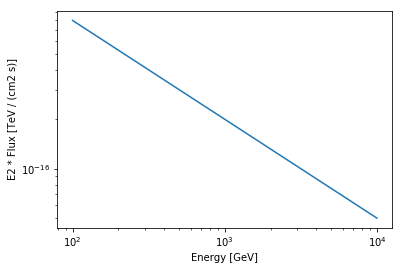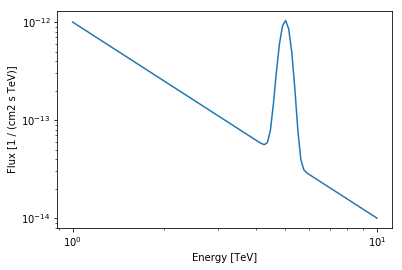This is a fixed-text formatted version of a Jupyter notebook.
You can contribute with your own notebooks in this GitHub repository.
Source files: spectrum_models.ipynb | spectrum_models.py
Spectral models in Gammapy¶
Introduction¶
This notebook explains how to use the functions and classes in gammapy.spectrum.models in order to work with spectral models.
The following clases will be used:
Setup¶
Same procedure as in every script …
In [1]:
%matplotlib inline
import matplotlib.pyplot as plt
In [2]:
import numpy as np
import astropy.units as u
from gammapy.spectrum import models
from gammapy.utils.modeling import Parameter, ParameterList
Create a model¶
To create a spectral model, instantiate an object of the spectral model class you’re interested in.
In [3]:
pwl = models.PowerLaw()
print(pwl)
PowerLaw
Parameters:
name value error unit min max frozen
--------- --------- ----- --------------- --- --- ------
index 2.000e+00 nan nan nan False
amplitude 1.000e-12 nan 1 / (cm2 s TeV) nan nan False
reference 1.000e+00 nan TeV nan nan True
This will use default values for the model parameters, which is rarely what you want.
Usually you will want to specify the parameters on object creation. One
way to do this is to pass astropy.utils.Quantity objects like this:
In [4]:
pwl = models.PowerLaw(
index=2.3 * u.Unit(''),
amplitude=1e-12 * u.Unit('cm-2 s-1 TeV-1'),
reference=1 * u.TeV,
)
print(pwl)
PowerLaw
Parameters:
name value error unit min max frozen
--------- --------- ----- --------------- --- --- ------
index 2.300e+00 nan nan nan False
amplitude 1.000e-12 nan 1 / (cm2 s TeV) nan nan False
reference 1.000e+00 nan TeV nan nan True
As you see, some of the parameters have default min and values
as well as a frozen flag. This is only relevant in the context of
spectral fitting and thus covered in
spectrum_analysis.ipynb.
Also, the parameter errors are not set. This will be covered later in
this tutorial.
Get and set model parameters¶
The model parameters are stored as ParameterList on the spectal
model. Each model parameter is Parameter instance. It has a
value and a unit attribute, as well as a quantity property
for convenience.
In [5]:
print(pwl.parameters)
print(pwl.parameters['index'])
pwl.parameters['index'].value=2.6
print(pwl.parameters['index'])
print(pwl.parameters['amplitude'])
pwl.parameters['amplitude'].quantity = 2e-12 * u.Unit('m-2 TeV-1 s-1')
print(pwl.parameters['amplitude'])
ParameterList
Parameter(name='index', value=2.3, unit='', min=nan, max=nan, frozen=False)
Parameter(name='amplitude', value=1e-12, unit='1 / (cm2 s TeV)', min=nan, max=nan, frozen=False)
Parameter(name='reference', value=1.0, unit='TeV', min=nan, max=nan, frozen=True)
Covariance:
None
Parameter(name='index', value=2.3, unit='', min=nan, max=nan, frozen=False)
Parameter(name='index', value=2.6, unit='', min=nan, max=nan, frozen=False)
Parameter(name='amplitude', value=1e-12, unit='1 / (cm2 s TeV)', min=nan, max=nan, frozen=False)
Parameter(name='amplitude', value=2e-12, unit='1 / (m2 s TeV)', min=nan, max=nan, frozen=False)
List available models¶
All spectral models in gammapy are subclasses of SpectralModel. The
list of available models is shown below.
In [6]:
models.SpectralModel.__subclasses__()
Out[6]:
[gammapy.spectrum.models.ConstantModel,
gammapy.spectrum.models.CompoundSpectralModel,
gammapy.spectrum.models.PowerLaw,
gammapy.spectrum.models.PowerLaw2,
gammapy.spectrum.models.ExponentialCutoffPowerLaw,
gammapy.spectrum.models.ExponentialCutoffPowerLaw3FGL,
gammapy.spectrum.models.PLSuperExpCutoff3FGL,
gammapy.spectrum.models.LogParabola,
gammapy.spectrum.models.TableModel,
gammapy.spectrum.models.AbsorbedSpectralModel,
gammapy.spectrum.crab.MeyerCrabModel]
Plotting¶
In order to plot a model you can use the plot function. It expects
an energy range as argument. You can also chose flux and energy units as
well as an energy power for the plot
In [7]:
energy_range = [0.1, 10] * u.TeV
pwl.plot(energy_range, energy_power=2, energy_unit='GeV')
Out[7]:
<matplotlib.axes._subplots.AxesSubplot at 0x10f326240>

Parameter errors¶
Parameters are stored internally as covariance matrix. There are,
however, convenience methods to set individual parameter errors on
ParameterList.
In [8]:
errors = dict(
index = 0.2 * u.Unit(''),
amplitude = 0.1 * pwl.parameters['amplitude'].quantity
)
pwl.parameters.set_parameter_errors(errors)
print(pwl)
PowerLaw
Parameters:
name value error unit min max frozen
--------- --------- --------- -------------- --- --- ------
index 2.600e+00 2.000e-01 nan nan False
amplitude 2.000e-12 2.000e-13 1 / (m2 s TeV) nan nan False
reference 1.000e+00 0.000e+00 TeV nan nan True
Covariance:
name/name index amplitude
--------- ----- ---------
index 0.04 0.0
amplitude 0.0 4e-26
You can access the parameter errors like this
In [9]:
print(pwl.parameters.covariance)
print(pwl.parameters.error('index'))
[[ 4.00000000e-02 0.00000000e+00 0.00000000e+00]
[ 0.00000000e+00 4.00000000e-26 0.00000000e+00]
[ 0.00000000e+00 0.00000000e+00 0.00000000e+00]]
0.2
You can plot the butterfly using the plot_error method.
In [10]:
ax = pwl.plot_error(energy_range, color='blue', alpha=0.2)
pwl.plot(energy_range, ax=ax, color='blue')
Out[10]:
<matplotlib.axes._subplots.AxesSubplot at 0x10fd1eb00>

Integral fluxes¶
You’ve probably asked yourself already, if it’s possible to integrated models. Yes, it is. Where analytical solutions are available, these are used by default. Otherwise, a numerical integration is performed.
In [11]:
integral = pwl.integral(emin=1 * u.TeV, emax= 10*u.TeV)
print(integral)
1.2186014196061302e-12 1 / (m2 s)
User-defined model¶
Now we’ll see how you can define a custom model. To do that you need to
subclass SpectralModel.
As an example we will use a PowerLaw plus a Gaussian (with fixed width).
In [12]:
class UserModel(models.SpectralModel):
def __init__(self, index, amplitude, reference, mean, width):
self.parameters = ParameterList([
Parameter('index', index, parmin=0),
Parameter('amplitude', amplitude, parmin=0),
Parameter('reference', reference, frozen=True),
Parameter('mean', mean, parmin=0),
Parameter('width', width, parmin=0, frozen=True)
])
def evaluate(self, energy, index, amplitude, reference, mean, width):
pwl = models.PowerLaw.evaluate(energy=energy, index=index, amplitude=amplitude, reference=reference)
gauss = amplitude * np.exp(-1 *(energy - mean) ** 2/( 2 * width ** 2))
return pwl + gauss
In [13]:
model = UserModel(
index=2 * u.Unit(''),
amplitude=1e-12 * u.Unit('cm-2 s-1 TeV-1'),
reference=1 * u.TeV,
mean=5 * u.TeV,
width=0.2 * u.TeV,
)
print(model)
UserModel
Parameters:
name value error unit min max frozen
--------- --------- ----- --------------- --- --- ------
index 2.000e+00 nan nan nan False
amplitude 1.000e-12 nan 1 / (cm2 s TeV) nan nan False
reference 1.000e+00 nan TeV nan nan True
mean 5.000e+00 nan TeV nan nan False
width 2.000e-01 nan TeV nan nan True
In [14]:
energy_range = [1, 10] * u.TeV
fig, ax = plt.subplots(1)
model.plot(ax=ax, energy_range=energy_range)
Out[14]:
<matplotlib.axes._subplots.AxesSubplot at 0x10fe31470>

What’s next?¶
In this tutorial we learnd how to work with spectral models. Go to gammapy.spectrum to see what else you can do with gammapy.spectrum.